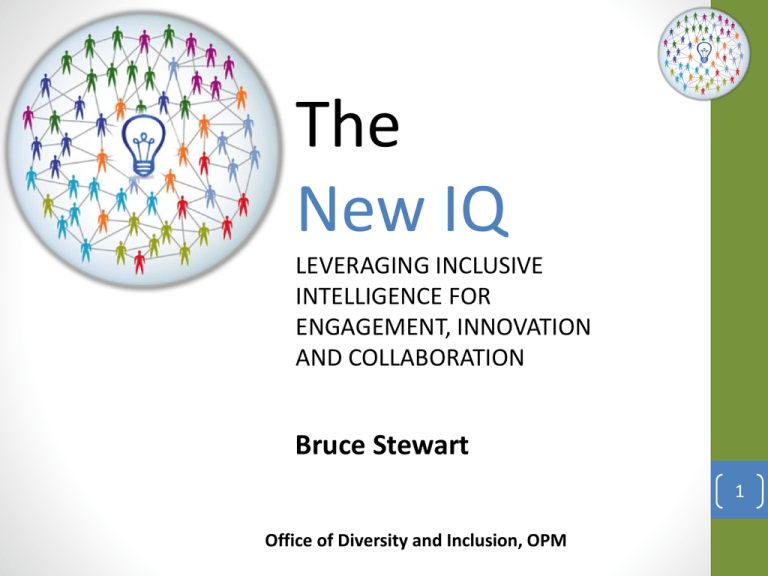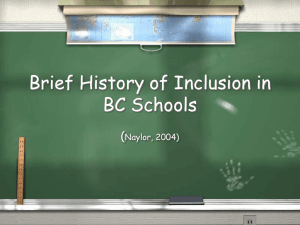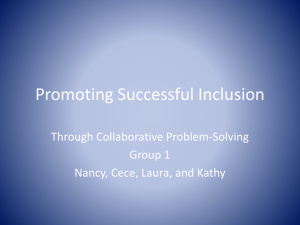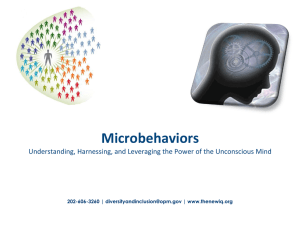New IQ-By Bruce Steward
advertisement

The New IQ LEVERAGING INCLUSIVE INTELLIGENCE FOR ENGAGEMENT, INNOVATION AND COLLABORATION Bruce Stewart 1 Office of Diversity and Inclusion, OPM Cultural Hunt Rule 1. Get out of our Comfort Zone… Faces Rule 2. Respect other Perspectives Why are these people not more Famous? Claudette Colvin Rosa Parks Alfred Russell Wallace Charles Darwin William Dawes Paul Revere We are Smarter like Win this… An interactive networked organization Win Win The New IQ A stable, robust, highperformance system Win Win Win Win Win Win Win Win INCLUSIVE LEVERAGING Win A Positive-Sum Win Win INTELLIGENCE FOR Win Game Win Win Win INNOVATION ENGAGEMENT, Win Win ANDWinCOLLABORATION Win Win Win We are less Smart like this… And even less Smart like this… A hierarchical segregated organization The New IQ A fragile, unstable, lowperformance system LEVERAGING INCLUSIVE A Zero-Sum Game INTELLIGENCE FOR ENGAGEMENT, INNOVATION AND COLLABORATION The “Real” Pain of Exclusion 8 Social Biases that create silos and limit our potential… “Like Me” Bias “Confirmation Bias “Broken Windows” Bias Is she a bike thief? 10 THE NEW IQ: INCLUSION Why we-smarts is better than me-smarts 11 Inclusion Defined Inclusion is… "the degree to which an employee perceives that he or she is an esteemed member of the work group through his or her needs for belongingness and uniqueness." 12 The New IQ = Inclusion Quotient Measures Inclusive Intelligence: The New IQ The intentional, deliberate, and proactive acts that increase work group intelligence by making people feel they “belong” and are “uniquely” valued. 13 In with the New and out with the Old… Old IQ Individual Smarts is less important New IQ Group Smarts is most important 14 New IQ Perception Scan Behavioral Statement 1 Others would say I do not tolerate arbitrary actions, personal favoritism and coercion for political purposes. 2 Others would say I do not tolerate prohibited personnel practices. Others would say I take steps to deal with poor performers who cannot or will not improve. Others would say I recognize differences in performance in a meaningful way. Others would say I give out awards based on how well employees perform their jobs. Others would say I reward creativity and innovation. Others would say I actively support policies and programs that promote diversity and inclusion in the workplace. 3 4 5 6 7 8 9 10 Others would say I am committed to a workforce representative of all segments of society. Others would say I work well with employees of different backgrounds. Others would say I actively promote communication among different work units. 11 Others would say I actively support collaboration across work units to accomplish work objectives. 12 Others would say I actively support the needs of Others to balance work and other life issues. 13 Others would say I regularly provide my subordinates with constructive suggestions to improve their job performance. Others would say I make time to listen to what they have to say. 14 Score 15 Others would say that I treat them with respect. 16 In the last six months, Others would say I have talked with them about their performance. 17 Others who depend on me would say they have enough information to do their job well 18 Others would say I encourage them to come up with new and better ways of doing things. 19 Others would say their talents are used well in the workplace. 20 Others have a feeling of personal empowerment with respect to work processes. 15 The New IQ: 5 Inclusive Habits Empowerment Supportive Cooperative Open Fair 16 The 80/20 Rule 17 Trim Tab 18 Becoming a Trim Tab at Work • Identify common themes • Using workbook write down examples from video Discussion of FranklinCovey Trim Tab Video When thinking about “how can I possibly create change in my organization,” think of being a trim tab. Your small actions, your work in your circle of influence can create, over time, a big impact on your organization. 19 If you do not intentionally, deliberately and proactively include, you will unintentionally exclude. 20 Scott Page “Progress depends as much on our collective differences as it does on our individual IQ scores” The Diversity Trumps Ability Theorem • The Difference • Mathematical truth “collective ability equals individual ability plus diversity” and that diversity trumps ability” 22 When all you have is hammers… 23 Everything looks like a nail… 24 We can do more with an assortment of tools… 25 A Class Divided A Class Divided… • Take 3 minutes and write your thoughts on why the kids performed at a lower level in their multiplication game. • Have you ever been impacted by Stereotype Threat? • Get in small groups and discuss your thoughts Section 1: Inclusion and Leadership Section 1 Objective: Within this section we will discuss what Inclusion really means to us, the two aspects of inclusion, and the basic building blocks to better understand the topic of Inclusion in your workplace • Inclusion Defined • Two Aspects of Inclusion • Inclusion Basics 28 Wrong mental maps lead to wrong solutions which lead to lost resources… Two Important Aspects of Inclusion Brewer's Optimal Distinctiveness Theory (ODT). This theory essentially explains the tension that people experience between the need to be a unique individual and the need to belong with others. Uniqueness Inclusion Belonging It is believed that this tension between belongingness and uniqueness is an underlying theme diversity and inclusion literature 30 Brewer's Optimal Distinctiveness Framework High value in uniqueness Low value in uniqueness Low Belongingness High belongingness Differentiation: Inclusion: Individual is not treated as an organizational insider in the work group but their unique characteristics are seen as valuable and required for group/ organization success. Individual is treated as an insider and also allowed/ encouraged to retain uniqueness within the work group. Exclusion: Assimilation: Individual is not treated as an organizational insider with unique value in the work group but there are other employees or groups who are insiders. Individual is treated as an insider in the work group when they conform to organizational/ dominant culture norms and downplay uniqueness. Individuals experience feelings of inclusion when a high value is placed on uniqueness with a corresponding high value on belongingness 31 Inclusion and Leadership Exercise Think about a time when you the leader of a successful team. 1. What were the characteristics that supported the team’s success? 2. How did people treat each other? 3. What was your role as a leader of the team and how did you enable team success? 32 Section 2: Foundations of New IQ Section 2 Objective: In this section you will be introduced to the New IQ , the brain science behind inclusion, and the importance of the Inner Work Life System. • • • • The New IQ Defined The Neuroscience of Inclusion The SCARF Model of the Brain The Inner Work Life System 33 The logic of diversity and inclusion • Diversity is not an imposition, it’s an advantage • Inclusion is not a problem, but it’s a solution • Working together is more than a good idea, it’s essential to individual and company success Innovation Quiz Rule 3. We are Smarter Together 38 Newspapers from the time estimated the size of the iceberg to be between 50-100 feet high and 200-400 feet long. Titanic was navigable for awhile and could have pulled aside the iceberg. Many people could have climbed aboard it to find flat places to stay out of the water for the four hours before help arrived. Fixated on the fact that icebergs sink ships, people overlooked the size and shape of the iceberg (plus the fact that it would not sink). Remember… Diversity + Inclusion = Better Performance Diversity Better Performance by accelerating the Inner Work Life Inclusion 40 Research for example… Conducted by Deloitte Australia 41 Neuroscience of Inclusion FACT: FACT: Our brains are wired for efficiency and speed. The neocortex is the area of the brain where we can imagine a new reality, where compassion and empathy reside. This basic wiring of the brain can work against us in communicating and working effectively across differences. FACT: Neuroscience research shows that our brain state directly impacts our perception. Our brain states impacts how we perceive others, events and our ability to foster relationships across differences. The competence of inclusion lies in our ability to intentionally access the neocortex. When we learn to recognize and manage our brain states, we increase our effectiveness in communicating and working together across differences and build new neuropathways. 42 Brain Tricks 43 The SCARF Model of the Brain 44 Model of Social Threats and Rewards Perceptions Emotions Motivations 45 Inner Work Life System “People do better work when they are happy, have positive views of the organization and its people, and are motivated primarily by the work itself.” (p, 47) “The Progress Principle” Perception Inner Work Life Motivation Emotion 46 47 Inner Work Life: Key Points • Every worker’s performance is affected by the constant interplay of perceptions, emotions, and motivations triggered by workday events, including managerial action-yet inner work life remains mostly invisible to management • Even seemingly mundane events – such as small wins and minor setbacks – can exert potent influence on inner work life • Negative events are more powerful than positive events, all else being equal 48 Exclusion Exercise Take a moment to reflect on a time when you were excluded or felt like an outsider. Most people can remember a time when they were kids and felt the pain of exclusion. Or, maybe there was a time at work when you were left out of the group. Not invited to lunch, or left out of an important project. See workbook for additional instructions In-group OutGroup 49 Section 3: The 5 Habits of Inclusive Leadership Section 3 Objective: In this section you will cover the 5 Habits of Inclusive Leadership • The New IQ: 5 Inclusive Habits 50 The New IQ: 5 Inclusive Habits Empowerment Supportive Cooperative Open Fair 51 The New IQ Logic to change culture through behavior change 20 Behaviors Culture Change 5 Habits Inclusive Environment 52 New IQ Scores Government Average 44% 56% 55% 74% 59% Fair Open Cooperative Supportive Empowered 54 Section 4: Making Habits Stick Section 4 Objective: In this section you will identify target behaviors and create new pathways for positive habits Identify Target Actions Use 3 Step Method to New Habit Shape Environment Identify Measurement System 55 3 Small Steps to Creating Habits 1. Shrink the change 2. Find a spot 3. Train the cycle everyday Shape your environment 56 But First, Your Story… • Who: Who were your parents? Grandparents? History? • What: What were the 3 events growing up that impacted you the most? • When: When were you born? Generational memories • Where: Where were you born? Spent most of your time growing up? Memories? • How: How were you raised? Parents or Grandparents? Strict? Religious? • Why: In your opinion why do good or bad things happen to people? The New IQ Perception Scan Complete the following New IQ Inclusive Intelligence Perception Scan using a scale of 1-5 (never, rarely, sometimes, often, always) Behavioral Statement 1 Others would say I do not tolerate arbitrary actions, personal favoritism and coercion for political purposes. 2 Others would say I do not tolerate prohibited personnel practices. Others would say I take steps to deal with poor performers who cannot or will not improve. Others would say I recognize differences in performance in a meaningful way. Others would say I give out awards based on how well employees perform their jobs. Others would say I reward creativity and innovation. Others would say I actively support policies and programs that promote diversity and inclusion in the workplace. 3 4 5 6 7 8 9 10 Others would say I am committed to a workforce representative of all segments of society. Others would say I work well with employees of different backgrounds. Others would say I actively promote communication among different work units. 11 Others would say I actively support collaboration across work units to accomplish work objectives. 12 Others would say I actively support the needs of Others to balance work and other life issues. 13 Others would say I regularly provide my subordinates with constructive suggestions to improve their job performance. Others would say I make time to listen to what they have to say. 14 15 Others would say that I treat them with respect. 16 In the last six months, Others would say I have talked with them about their performance. 17 Others who depend on me would say they have enough information to do their job well 18 Others would say I encourage them to come up with new and better ways of doing things. 19 Others would say their talents are used well in the workplace. 20 Others have a feeling of personal empowerment with respect to work processes. Score The Titanic







